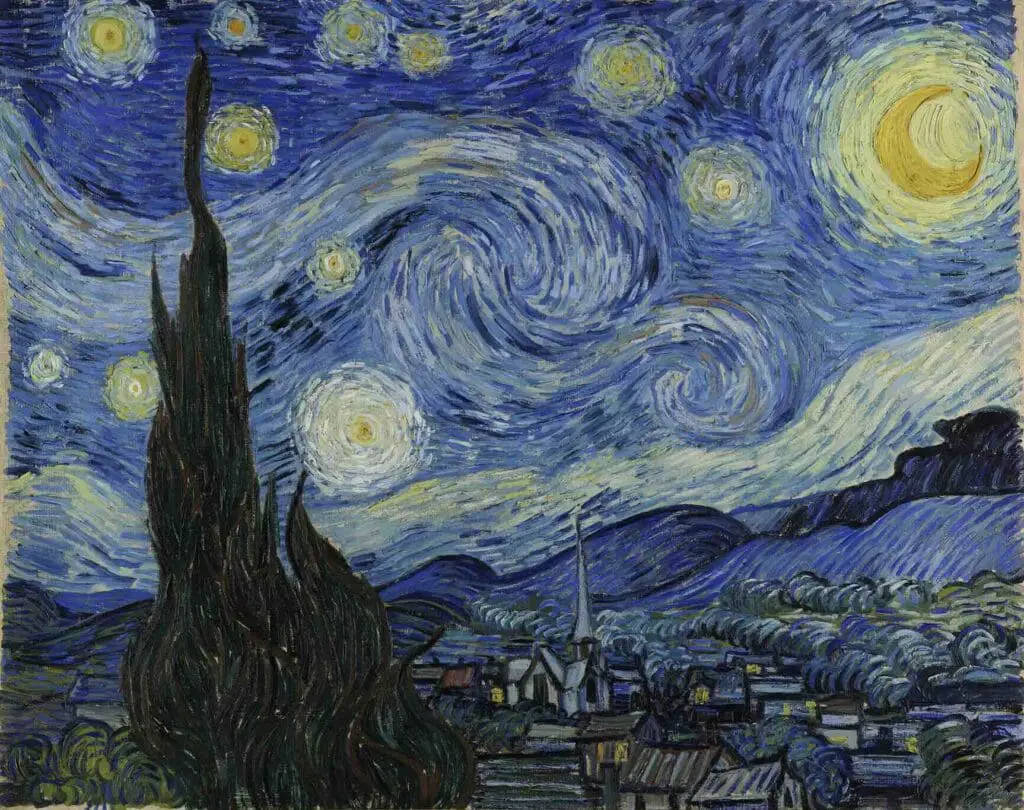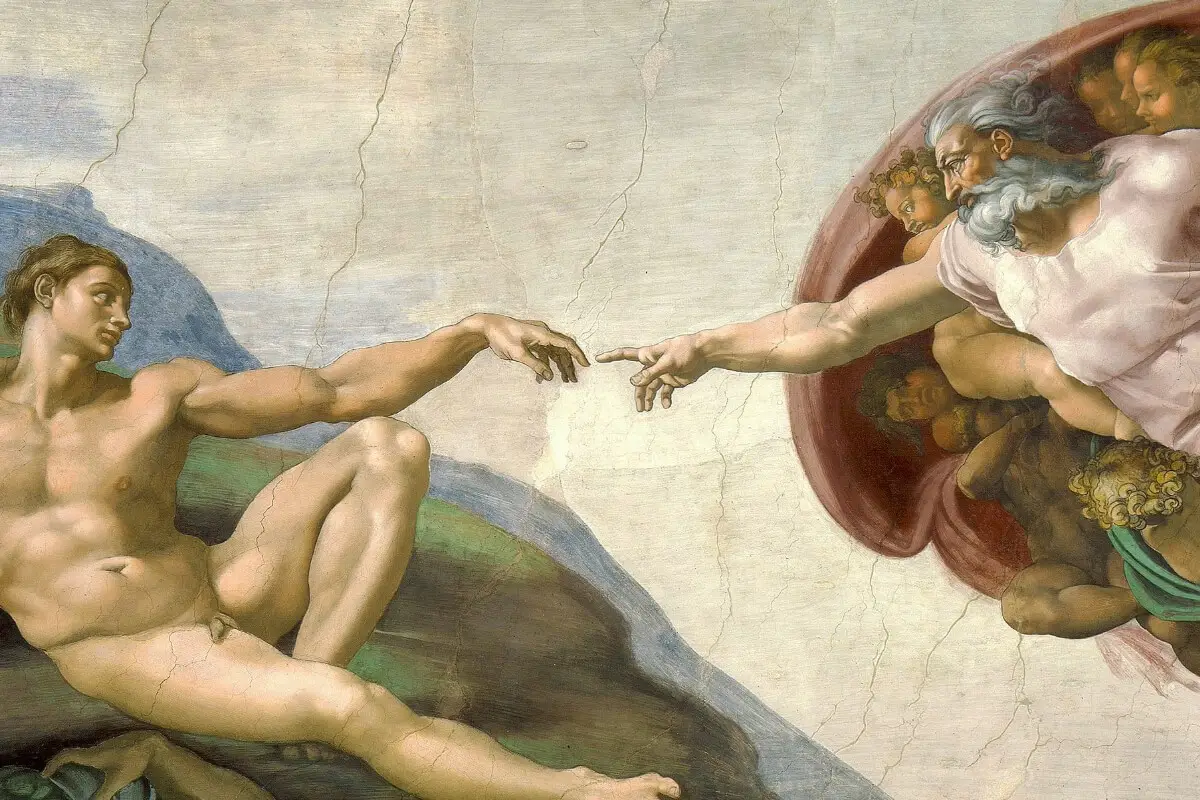The Mona Lisa’s smile, a starry night sky swirling with emotion, the divine drama unfolding on the Sistine Chapel ceiling, the stark outcry against the war in Guernica, and the ethereal beauty of Venus emerging from the sea—these iconic images serve as windows into the profound depths of human creativity and expression.
Each piece, a testament to the era and mind from which it sprung, invites us on a journey through the landscapes of art history, psychology, and cultural significance. This narrative seeks to illuminate the intricate tapestry woven by artists through their masterpieces, revealing not just the beauty on the surface but the rich layers of meaning and emotion beneath.
Table of Contents
- The Mona Lisa’s Enigmatic Smile
- The Starry Night’s Turbulent Emotions
- The Sistine Chapel Ceiling: A Divine Masterpiece
- Related Questions
The Mona Lisa’s Enigmatic Smile
Leonardo da Vinci painted the Mona Lisa over several years, starting in 1503. Despite its centuries-old origins, the allure of the subject’s smile remains powerful. Da Vinci’s avante-garde techniques merit much of the credit.
He employed the sfumato technique, which allows tones and colors to graduate into one another, creating a soft, blurred outline. This technique plays a critical role in the mesmerizing effect of the Mona Lisa’s smile, making it appear to change when viewed from different angles or in varying light.

Portraiture was evolving at the time. Da Vinci elevated the art form, infusing it with psychological depth. Observers often find themselves drawn into a silent conversation with the Mona Lisa. They describe her smile as elusive and ever-changing—happy or sad, depending on their perception. This ambiguity sparks curiosity and fascination.
The psychological impact of the painting has undergone scientific scrutiny. Studies utilizing eye-tracking technology reveal that viewers’ emotions can shift as they gaze at the painting, responding to the subtlest changes in the Mona Lisa’s expression. This suggests that da Vinci understood how to engage the viewer on a deeply emotional level.
Beyond its artistic mastery, the Mona Lisa’s history bears layers of cultural significance. Once stolen in 1911 and recovered two years later, it has survived centuries to become a symbol of enduring allure. It’s drawn crowds from all corners of the globe, making it one of the Louvre’s most-visited artworks.
The Mona Lisa’s smile opens pathways to analyzing human psychology and examining the beauty standards of the time. Further studies suggest that Mona Lisa’s smile was considered ideal during the Renaissance, capturing an essence of femininity, mystery, and elegance.
Moreover, her identity fuels ongoing debates—was she a real person or the embodiment of an ideal woman? These mysteries deepen her allure, ensuring her continued status as a mystery and beauty global icon.
Cultural references abound, stretching Mona Lisa’s influence beyond the confines of art history into music, literature, and pop culture, demonstrating her universal appeal and the timeless nature of art that evokes more questions than answers.
Each discovery about the painting, whether it resolves old questions or raises new ones, adds a layer to its legend. It reflects humanity’s endless quest for meaning in beauty and how such icons connect deeply across diverse cultures and eras.
The Starry Night’s Turbulent Emotions
Vincent van Gogh’s “The Starry Night,” painted in 1889 during his stay at the asylum of Saint-Paul-de-Mausole, is a compelling study of the artist’s heightened emotional and psychological state. Van Gogh’s experiences with mental illness profoundly influenced this iconic piece, reflecting a tumultuous mix of hope, despair, and a quest for solace.
The swirling, vibrant sky in “The Starry Night” suggests dynamic movement and energy contrasting with the peaceful village below. This contrast can be interpreted as Van Gogh’s struggle between chaos and calm within his mind. The exaggerated, almost fantastical portrayal of the night sky, filled with bright stars and a crescent moon, emanates a sense of longing—perhaps for stability or belonging.

Color plays a significant role in conveying emotion in “The Starry Night.” The use of deep blues and bright yellows creates a sharp contrast that highlights the intensity of Van Gogh’s emotional state.
This color contrast is not just visually striking; it symbolizes the inner conflict and turmoil he experienced. The lively yellow stars and moon stand out against the cool, somber blues and create a sense of turbulence in the night sky, reflecting Van Gogh’s unsettled feelings.
Furthermore, the cypress tree towering in the foreground, reaching up towards the sky, can be seen as a bridge between heaven and earth, life and death. Trees, especially cypresses, often symbolize eternity and the afterlife in Van Gogh’s work. This tree, set against the tumultuous backdrop of the night sky, might represent Van Gogh’s contemplation of his mortality and his search for enduring truth beyond his present woes.
“The Starry Night” is not just a depiction of a scenic landscape but is loaded with Van Gogh’s symbols. For instance, despite being in a quiet village, the church steeple doesn’t find its mirror image in the sky, possibly hinting at Van Gogh’s feeling of disconnection from faith or a higher power in his moments of suffering.
Analyzing “The Starry Night” as a point in the development of expressionism reveals how Van Gogh’s vision paved the way for future artists to explore their inner worlds. This masterpiece encourages viewers to feel rather than analyze, providing a raw, unfiltered glimpse into the artist’s soul. By projecting his internal struggles onto the canvas, Van Gogh offers us a vivid exploration of the human condition—a theme as relevant today as it was in the late 19th century.
Through “The Starry Night,” Van Gogh communicates his struggle and an unbreakable spirit in the face of overwhelming adversity. Even as he wrestled with his mental demons, he managed to create art that was brilliantly alive, testifying to the enduring power of human creativity over despair. This work remains an essential cultural artifact, inspiring artists and anyone who seeks beauty and meaning amid struggle.
The Sistine Chapel Ceiling: A Divine Masterpiece
Michelangelo’s work on the Sistine Chapel Ceiling
He broke new ground in artistic expression during the High Renaissance, setting a benchmark for future artists. Despite being primarily known as a sculptor, his leap into fresco painting brought forth a level of depth, realism, and emotional intensity previously unseen.
At the heart of this transformation was Michelangelo’s insistence on painting the ceiling himself, challenging the norms of the day, which often involved delegating such large tasks to a team of artists.

The ceiling’s intricate design, featuring over 300 figures across various Biblical scenes, showcased Michelangelo’s adept understanding of human anatomy and movement. His figures were dynamic and muscular and showed an unprecedented level of detail and vitality.
This was a departure from his predecessors’ and contemporaries’ more static and idealized figures. Michelangelo’s figures seem to move within the architectural constraints of the ceiling, a testament to his innovative use of perspective and foreshortening.

One of the central panels of the ceiling, The Creation of Adam, exemplifies Michelangelo’s brilliant use of fresco to depict the divine spark of life transferring from God to man. The touch of God’s finger reaching out to Adam became an iconic symbol of humanity’s connection to the divine, highlighting Michelangelo’s ability to convey complex theological ideas through subtle gestures and compositions.
Furthermore, Michelangelo incorporated various artistic techniques to achieve depth and three-dimensionality on a flat ceiling. His use of chiaroscuro, the contrast between light and shadow, added a dramatic effect to the scenes, enhancing their emotional impact on viewers.
Despite numerous physical and emotional challenges, his dedication to the project, including working atop a high scaffolding for four arduous years, speaks to Michelangelo’s unwavering commitment to his art. Such perseverance under adversity became a source of inspiration for artists who followed, symbolizing the artist’s struggle for creative expression.
The Sistine Chapel Ceiling also altered the course of art history regarding its critical reception. Initially met with awe and praise, it elevated Michelangelo’s status as an artist, firmly establishing him as a master of the High Renaissance. His approaches influenced countless artists, ushering in new trends in art that emphasized human emotion, anatomical accuracy, and intricate compositions.
In essence, Michelangelo’s work on the Sistine Chapel Ceiling redefined the parameters of Renaissance art, blending technical prowess with a profound exploration of human nature and divine interaction.
It heralded a shift towards a more personal and reflective depiction of Biblical narratives, offering viewers a poignant, immersive experience that continues to captivate and inspire. Michelangelo’s frescoes’ legacy lives on, not just as monumental achievements in art but as timeless embodiments of human ingenuity and creativity.
In essence, through a detailed examination of these masterpieces, we uncover the technical brilliance and historical context that define them and the universal themes of human experience they encapsulate.
The Mona Lisa’s enigmatic smile, perhaps symbolic of these themes, is a poignant reminder of art’s enduring power to engage, mystify, and inspire across centuries. It symbolizes art’s timeless quest to capture human emotion’s ineffable beauty and complexity, ensuring its relevance and resonance with audiences across diverse cultures and eras.
Anita Louise Art is dedicated to art education, great artists, and inspiring others to find and create their art. We love art that uplifts and inspires. #ArtToMakeYouSmile! #ArtToMakeYouHappy!
If you want to see any of my art, you can find out more by clicking here. If you are interested in what inspires me and my paintings, you can discover more by clicking here.
We have a free newsletter and would love you to be part of our community; you can subscribe to the newsletter by clicking here. I would be happy to talk to you if you have any questions. You can reach me, Anita, by clicking here.
Subscribe to our Anita Louise Art YouTube Channel with great videos and information by clicking here.
Join us for our podcast “5 Minutes With Art.” Spend just 5 minutes a week with us to discover and learn about great art and artists. You can find out more about our podcast by clicking here.
Related Questions
Unraveling the Mystery: Colors and Their Association with Sadness
Color, an integral part of our daily lives, is a powerful communication tool that influences our emotions and actions without realizing it. Different colors evoke various feelings and emotional responses in people, contributing significantly to our perception of the world around us. This essay delves into one particular emotion — sadness, examining its correlation with color from diverse perspectives: psychological, historical, cultural, and contemporary art.
By clicking here, you can learn more by reading Unraveling the Mystery: Colors and Their Association with Sadness.
Art And History – Understanding Our Past
When we study art, it helps us understand and gives us clues about the past. As we see what the artist has painted, we can piece together what life was like during that time in history. Art also helps us better understand the cultures and people who once lived their life.
You can discover more by reading Art and History – Understanding Our Past by clicking here.
Francisco Goya’s Black Paintings: A Descent Into Darkness
The art world has witnessed a multitude of masterpieces, but few are as enigmatic and intensely personal as Francisco Goya’s Black Paintings. Perhaps no other paintings than the series of black paintings show the mind of Francisco Goya and what he was going through.
By clicking here, you can discover more by reading Francisco Goya’s Black Paintings: A Descent Into Darkness.

